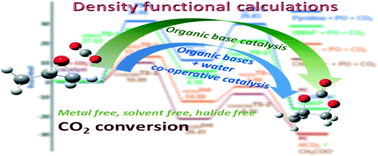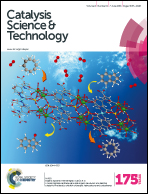A computational study of the mechanistic insights into base catalysed synthesis of cyclic carbonates from CO2: bicarbonate anion as an active species†
Abstract
The standalone catalytic potential of common organic bases such as imidazole, pyridine and dimethylaminopyridine (DMAP) for the solvent-free cycloaddition of CO2 with epoxides yielding five-membered cyclic carbonates is reported here. Appreciable conversion of various epoxides with excellent selectivity towards the desired products was materialized in this metal/halide/hydrogen bond donors/solvent-free reaction. The presence of catalytic amounts of water was found significantly advantageous in this base catalyzed chemical fixation of CO2 and the conversion almost got doubled or tripled under the same reaction conditions. A definitive mechanism for the activation of base catalysis was also proposed with the aid of ab initio calculations performed at the B3LYP/6-31G(d,p) level. Besides, a bicarbonate anion mediated catalytic cycle was also proposed utilizing computational calculations. The possible intermediates and transition states as well as the related energy constraints of the base alone and base–water catalyzed reactions were deduced and the activation energy obtained was found higher for the former (∼30 kcal mol−1) than for the latter (∼12 kcal mol−1), which rationalizes the experimental observation of the higher activity of the latter.


 Please wait while we load your content...
Please wait while we load your content...